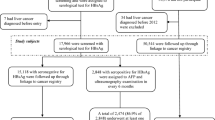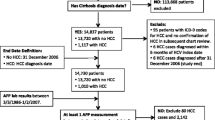Abstract
Purpose: To determine whether repeated screening can lead to early detection of primary liver cancer (PLC) and in turn to an improved clinical result.Methods: In this randomized controlled study, Shanghai urban residents aged 35–55 years and with serum evidence of HBV infection or chronic liver disease were eligible for recruitment. Using cluster sampling, these subjects were allocated into two groups — the screening group and the control group: there were 8109 subjects in the screening group and 9711 in the control group. Subjects in the screening group were tested with serum AFP and real-time ultrasound every 6 months. One to four rounds of screening were completed. Liver cancer was treated according to stage at diagnosis.Results: All subjects enrolled were followed up and classed at the end-point as alive without liver cancer, alive with liver cancer, dead from liver cancer, or dead from another cause. The mean follow-up was 1.2 years; total followup was 12,038 person-years in the screening group and 9,573 person-years in the control group. We detected 38 patients with PLC in the screening group and 18 patients with PLC in the control group. In the patients in the screening group 76.8% of patients were at a subclinical stage, and 70.6% of them underwent resection, the 1- and 2-year survival rates being 88.1% and 77.5%, respectively. However, in the control group, none of the patients was at a subclinical stage when diagnosed, none of them underwent resection, and none of them survived over 1 year. The lead time was estimated at 0.45 years. The cost of detecting PLC at an early stage was RMB 12,600 (US$ 1,500).Conclusion: The study proved that screening the high-risk population for PLC with a serum AFP test and real-time ultrasound examination can detect patients in the early stages, increase the resection rate and prolong the survival time. It is therefore recommended that screening for PLC be advocated in any high-risk area.
Similar content being viewed by others
References
Imberti D, Fornari F (1993) Hepatocellular carcinoma in liver cirrhosis, a prospective study. Scand J Gasteroenterol 28:540–545
Kang JK, Lee TP, Yap I (1992) Analysis of cost-effectiveness of different strategies for hepatocellular carcinoma screening in hepatitis B virus carriers. J Gastroenterol Hepatol 7:463–468
Shen QJ, Zhou XP (1995) A case-control study to evaluate the effect of screening for hepatoma. Tumor 15:174–76
Tanikawa K (1993) Early detection of hepatocellular carcinoma — high-risk group and mass survey. Jpn J Cancer Chemother 20:864–868
Zhang BH, Yang BH, Yu ZY (1995) The study of high-risk population for primary liver cancer. Tumor 15:80–82
Author information
Authors and Affiliations
Additional information
This work was partly supported by China Medical Board grant no: 93-583: Primary Liver Cancer
Rights and permissions
About this article
Cite this article
Yang, B., Zhang, B., Xu, Y. et al. Prospective study of early detection for primary liver cancer. J Cancer Res Clin Oncol 123, 357–360 (1997). https://doi.org/10.1007/BF01438313
Received:
Accepted:
Issue Date:
DOI: https://doi.org/10.1007/BF01438313




